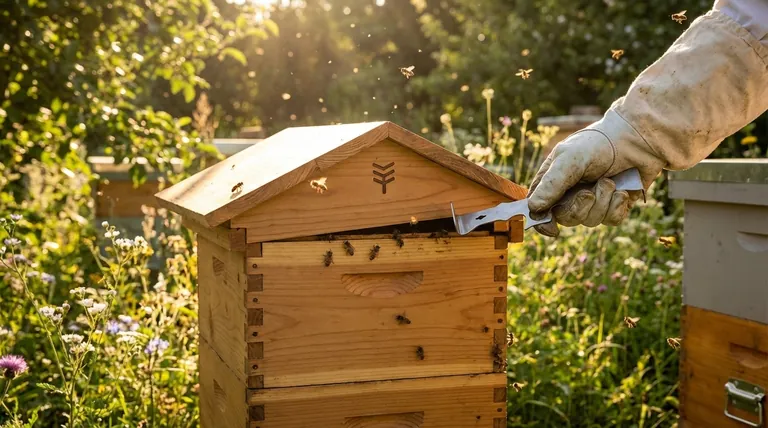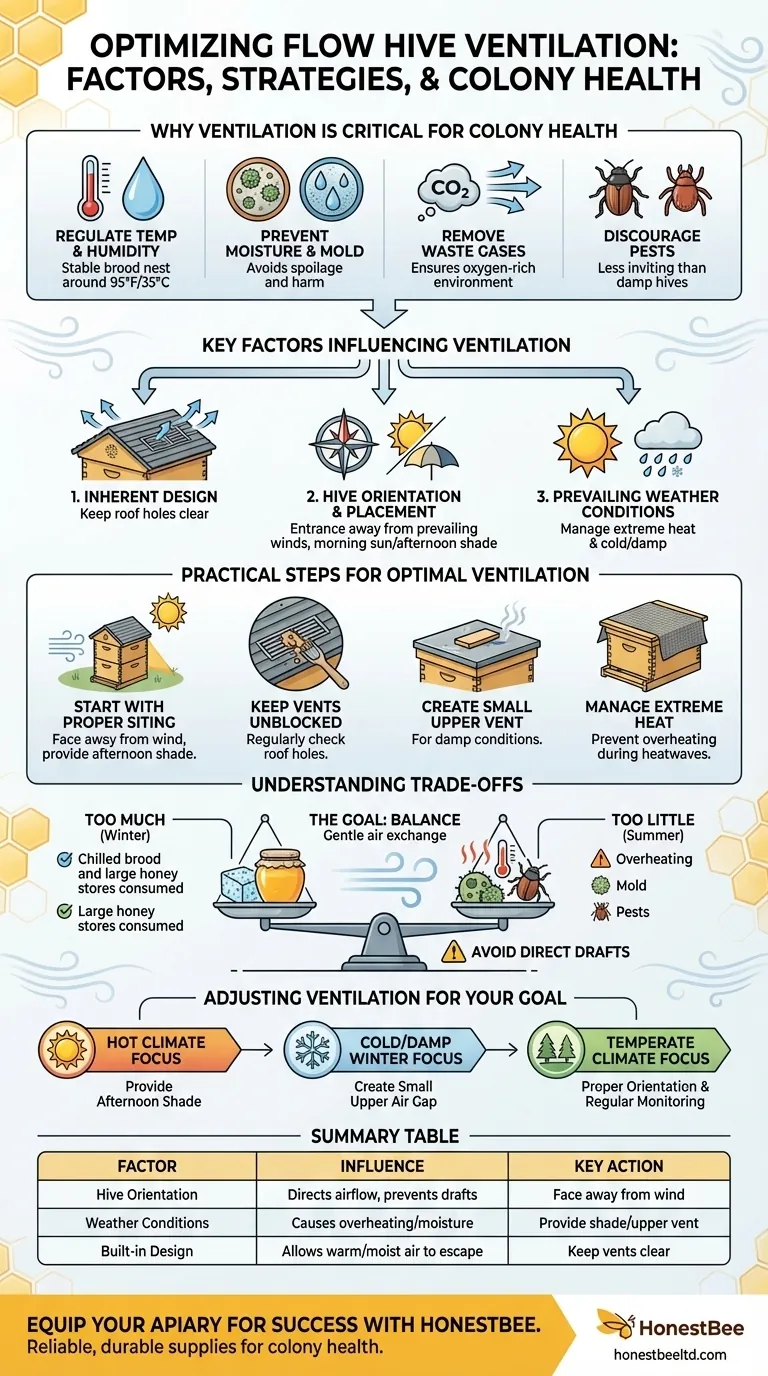To achieve optimal ventilation in a Flow Hive, you must manage three key factors: the hive's orientation, the local weather, and the hive's built-in design features. The most effective strategies involve positioning the entrance away from prevailing winds, ensuring the roof’s ventilation holes remain unblocked, and providing shade or insulation during extreme weather.
Proper ventilation is not about creating a draft; it's about assisting the bees in their natural regulation of temperature and humidity. Getting this balance right is one of the most critical factors in preventing disease and ensuring a healthy, productive colony.

Why Ventilation is Critical for Colony Health
A beehive is a finely tuned ecosystem. The bees work constantly to maintain a specific internal temperature and humidity level. Proper ventilation is your primary tool for helping them succeed.
Regulating Temperature and Humidity
Bees maintain the core of their brood nest at a stable temperature (around 95°F or 35°C). Inadequate airflow can trap heat in the summer or cold, damp air in the winter, forcing the colony to expend critical energy to correct the imbalance.
Preventing Moisture and Mold
A colony of bees produces a significant amount of moisture through respiration. Without a way for this warm, moist air to escape, it will condense on the hive's inner surfaces, promoting the growth of mold and fungus that can harm the bees and spoil honey.
Removing Waste Gases
Respiration also produces carbon dioxide. Proper air exchange is necessary to vent CO2 and other waste gases, ensuring the bees have a healthy, oxygen-rich environment.
Discouraging Pests
Excessive moisture creates an ideal breeding ground for pests like small hive beetles and mites. A dry, well-ventilated hive is a much less inviting target for these harmful invaders.
Key Factors Influencing Flow Hive Ventilation
Achieving optimal ventilation requires understanding the forces at play, both inside and outside the hive.
The Hive's Inherent Design
The Flow Hive is designed with ventilation in mind. The roof includes small holes specifically to allow warm, moist air to escape. It is crucial that these vents are kept clear of debris.
Hive Orientation and Placement
Where you place your hive has a significant impact. The entrance should face away from prevailing winds to prevent drafts that can chill the colony. Placing the hive where it can get morning sun but afternoon shade helps with temperature regulation.
Prevailing Weather Conditions
Extreme weather is the biggest challenge to ventilation. Intense summer heat can cause the colony to overheat, while long periods of cold, damp weather can lead to dangerous moisture buildup.
Practical Steps for Optimal Ventilation
You can take several straightforward actions to support your hive's natural air exchange.
Start with Proper Siting
Position your hive correctly from day one. Face the entrance away from strong, persistent winds and consider a location that provides natural shade during the hottest part of the summer afternoon.
Keep Vents Unblocked
Regularly check that the ventilation holes in the roof of your Flow Hive are clear. Propolis or debris can sometimes block these small but essential openings.
Create a Small Upper Vent
In damp conditions, creating a slight gap at the top of the hive can dramatically improve air circulation. Simply placing a small stick or shim under one edge of the top cover allows moist air to escape more easily.
Manage Extreme Heat
During heatwaves, providing artificial shade with a board or shade cloth can prevent the hive from overheating and reduce the bees' need for fanning and bearding (clustering outside the hive).
Understanding the Trade-offs
More ventilation is not always better. The goal is balance, not maximum airflow.
Too Much Ventilation in Winter
Excessive airflow during cold weather can be detrimental. It can chill the brood and force the bees to consume more of their winter stores to generate the heat needed to keep their cluster warm.
Too Little Ventilation in Summer
This is the most common problem. Insufficient airflow in hot, humid weather leads to overheating and condensation, creating the perfect conditions for mold, mildew, and pests.
The Danger of a Direct Draft
There is a critical difference between gentle, passive air exchange and a direct draft. A draft that blows straight through the brood nest will cause severe stress to the colony. This is why facing the entrance away from prevailing winds is so important.
Adjusting Ventilation for Your Goal
Your approach should be tailored to your specific environment and the needs of your colony.
- If your primary focus is surviving a hot climate: Providing afternoon shade is the most critical action to prevent the colony from overheating.
- If your primary focus is managing a cold, damp winter: Creating a small upper air gap is essential for allowing moisture to escape and preventing mold.
- If your primary focus is general hive health in a temperate climate: Proper hive orientation and regular monitoring of the built-in vents will be your most effective tools.
Ultimately, effective ventilation is about actively assisting your bees in maintaining the stable internal environment they need to thrive.
Summary Table:
| Factor | Influence on Ventilation | Key Action |
|---|---|---|
| Hive Orientation | Directs airflow, prevents drafts | Face entrance away from prevailing winds |
| Weather Conditions | Causes overheating or moisture buildup | Provide shade in summer, upper vent in winter |
| Built-in Design | Allows warm, moist air to escape | Keep roof ventilation holes clear |
Equip your apiary for success with HONESTBEE. Proper hive ventilation is fundamental to colony health and honey production. As a commercial beekeeper or equipment distributor, you need reliable, durable supplies to manage your hives effectively. HONESTBEE supplies the high-quality beekeeping equipment and wholesale supplies you need to ensure optimal conditions for every hive in your operation. Let's discuss your specific needs – contact our experts today to enhance your beekeeping productivity.
Visual Guide

Related Products
- HONESTBEE Advanced Ergonomic Stainless Steel Hive Tool for Beekeeping
- HONESTBEE Professional Long Handled Hive Tool with Precision Cutting Blade
- Professional Dual-End Stainless Steel Hive Tool for Beekeeping
- Professional Galvanized Hive Strap with Secure Locking Buckle for Beekeeping
- Yellow Plastic Bucket Pail Perch for Beekeeping
People Also Ask
- What tools are used for cleaning frames? A Beekeeper's Simple 4-Tool Guide
- What is the hole in a hive tool for? A Multi-Tool for Apiary Repairs and Maintenance
- What are the basic tools for beekeeping? Essential Starter Kit for Safe & Successful Hive Management
- What are some common uses of a hive tool? Essential Multi-Purpose Tool for Every Beekeeper
- Why do hive tools have a hole? Unlock the Secret to Efficient Beekeeping



















